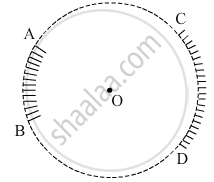Advertisements
Advertisements
प्रश्न
Size of image of an object by a mirror having a focal length of 20 cm is observed to be reduced to 1/3rd of its size. At what distance the object has been placed from the mirror? What is the nature of the image and the mirror?
उत्तर
Case I: (In case of convex mirror)
Magnification, `"m" = 1/3` (convex mirror)
Focal length (f) = 20 cm
Size of image `("h"_"i") = 1/3 xx "h"_"o"` (Size of object)
Using the magnification formula,
`"m" = "h"_"i"/"h"_"o" = (-upsilon)/"u"`
Substituting the values in the above equation,
`("h"_"o"/3)/"h"_"o" = (-upsilon)/"u"`
`1/3 = (-upsilon)/"u"`
`upsilon = (-"u")/3`
Using the mirror formula,
`1/upsilon + 1/"u" = 1/"f"`
`(-3)/"u" + 1/"u" = 1/20`
`(-2)/"u" = 1/20`
u = -40 cm
Negative sign shows that the object is in front of the mirror.
Substituting the above value in obtained image distance and object distance relation,
`upsilon = -u/3 = - ((-40))/3 = 40/3` cm
Thus, the image formed is virtual, erect and diminished. The object is at a distance of 40 cm from the mirror.
Case II: In case of concave mirror
Magnification, `"m" = -1/3` (concave mirror)
Focal length (f) = -20 cm
Using the magnification formula,
`"m" = "h"_"i"/"h"_"o" = (-upsilon)/"u"`
Substituting the values in the above equation,
`(-1)/3 = (-upsilon)/"u"`
`1/3 = upsilon/"u"`
`upsilon = "u"/3`
Using the mirror formula,
`1/upsilon + 1/"u" = 1/"f"`
`3/"u" + 1/"u" = 1/(-20)`
`4/"u" = 1/(-20)`
u = -80 cm
`upsilon = "u"/3 = -80/3` cm
Thus, the image will be real and inverted. The object is at a distance of 80 cm from the mirror.
APPEARS IN
संबंधित प्रश्न
What do you mean by the term dispersion?
AB and CD, two spherical mirrors, from parts of a hollow spherical ball with its centre at O as shown in the diagram. If arc AB = `1/2` arc CD, what is the ratio of their focal lengths? State which of the two mirrors will always form virtual image of an object placed in front of it and why.
State the types of mirrors used for (i) headlights and (ii) rear view mirror, in cars and motorcycles. Give to justify your answer in each case.
The image formed by a convex mirror is of size one third the size of object. How are u and v related?
A concave mirror forms a real image of an object placed in front of it at a distance 30 cm, of size three times the size of object. Find (a) the focal length of mirror (b) position of image.
What do you understand by the term real image?
Does the mirror name by your form a real image for all locations? Give a reason for your answer.
What is the focal length (f) of a mirror?
